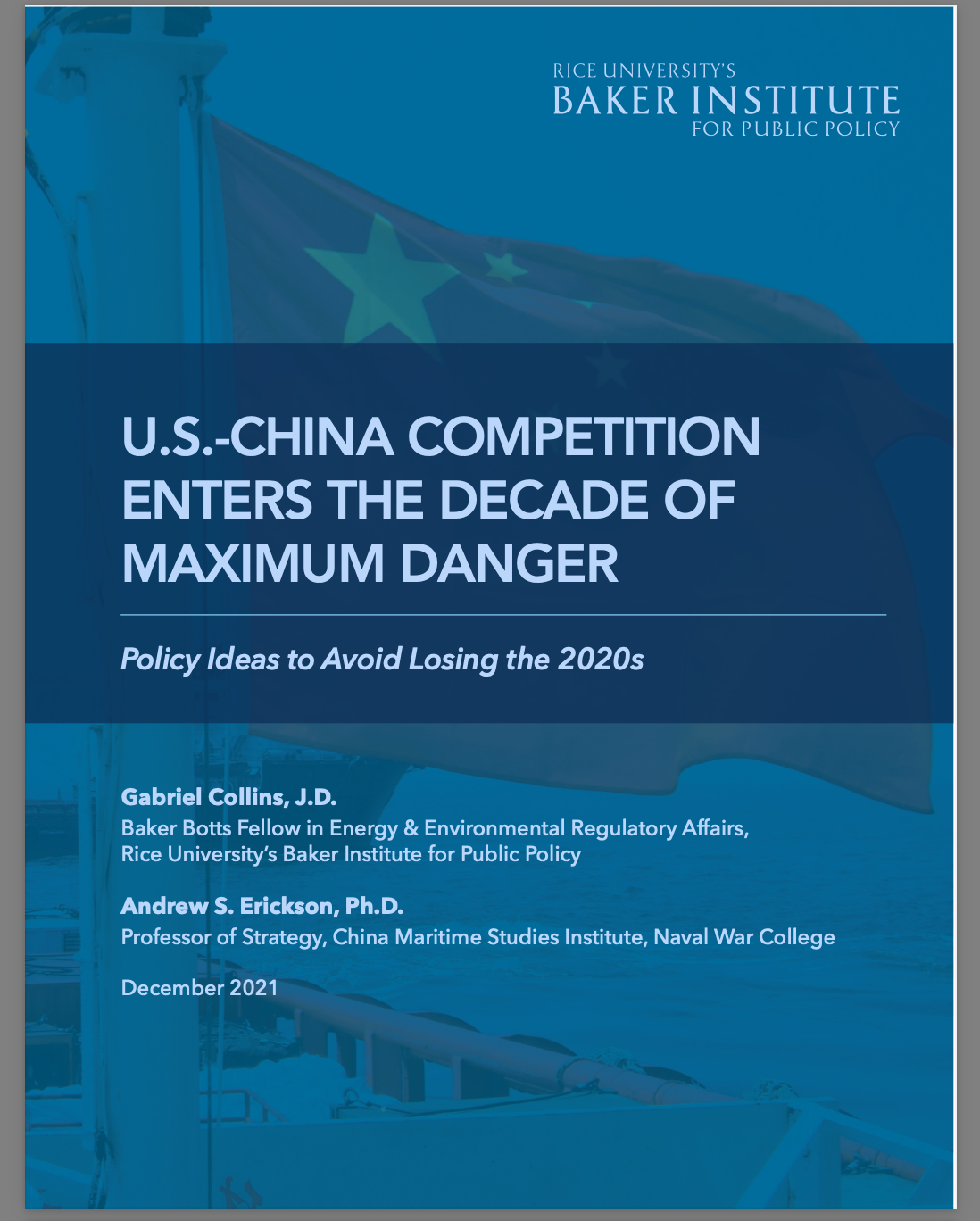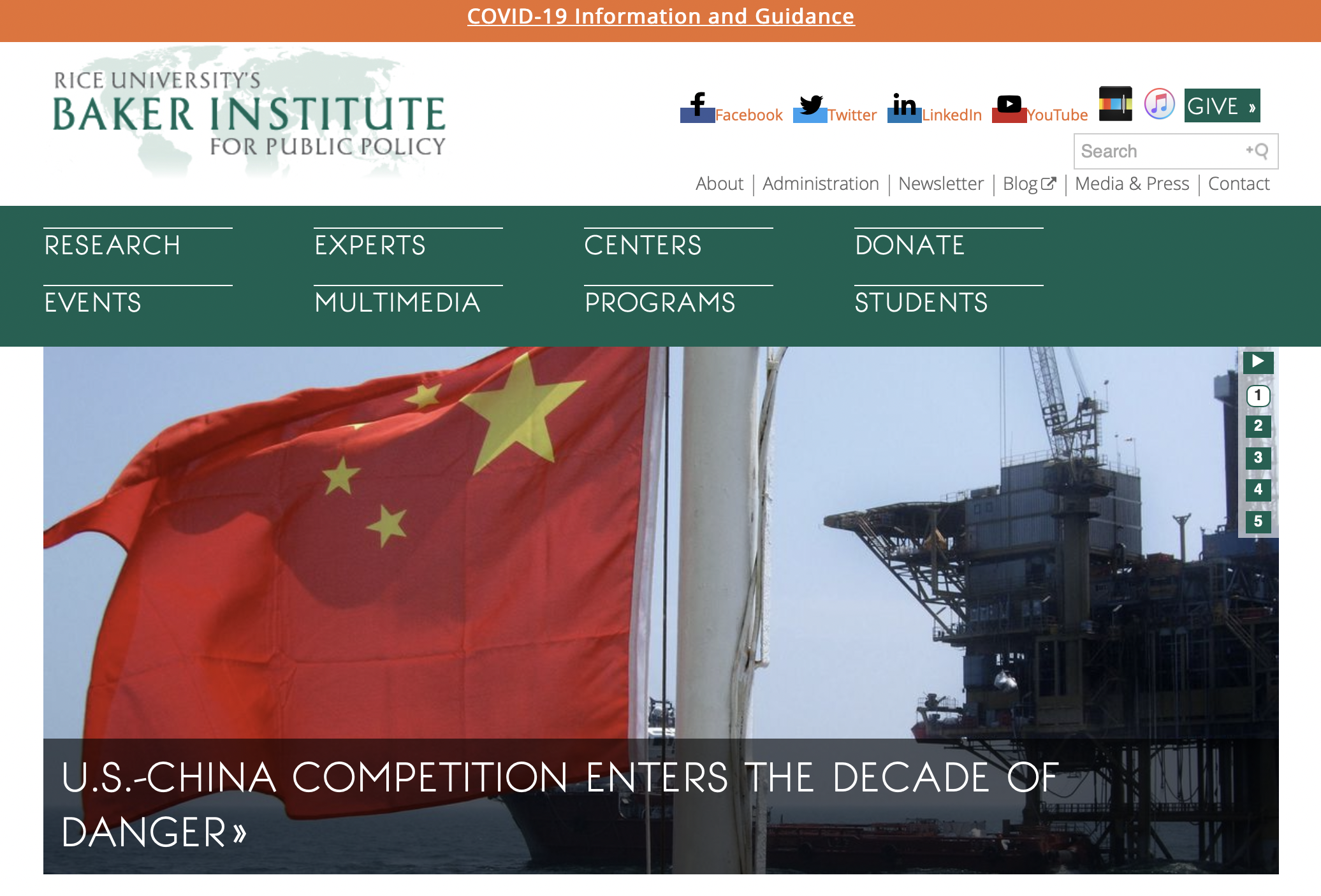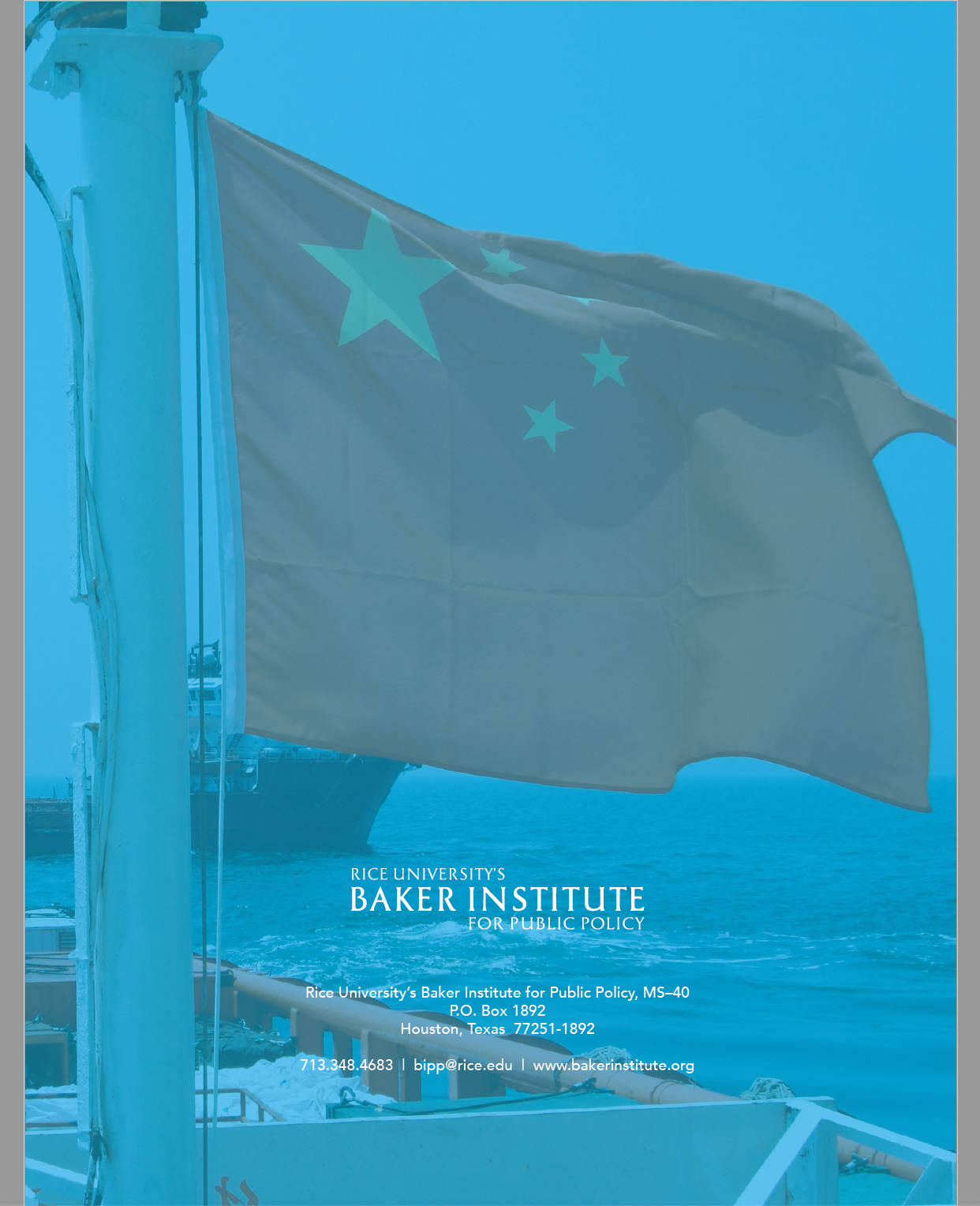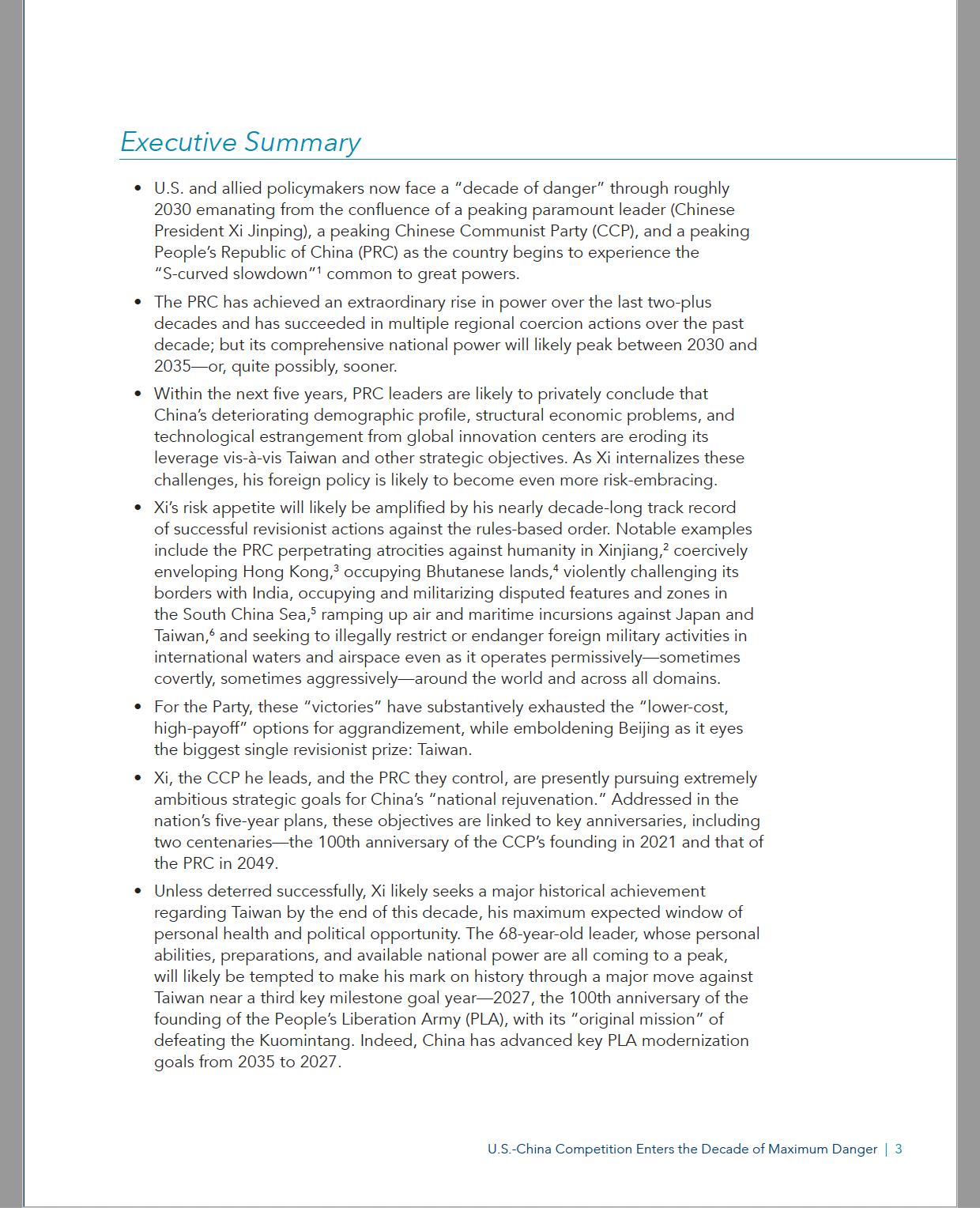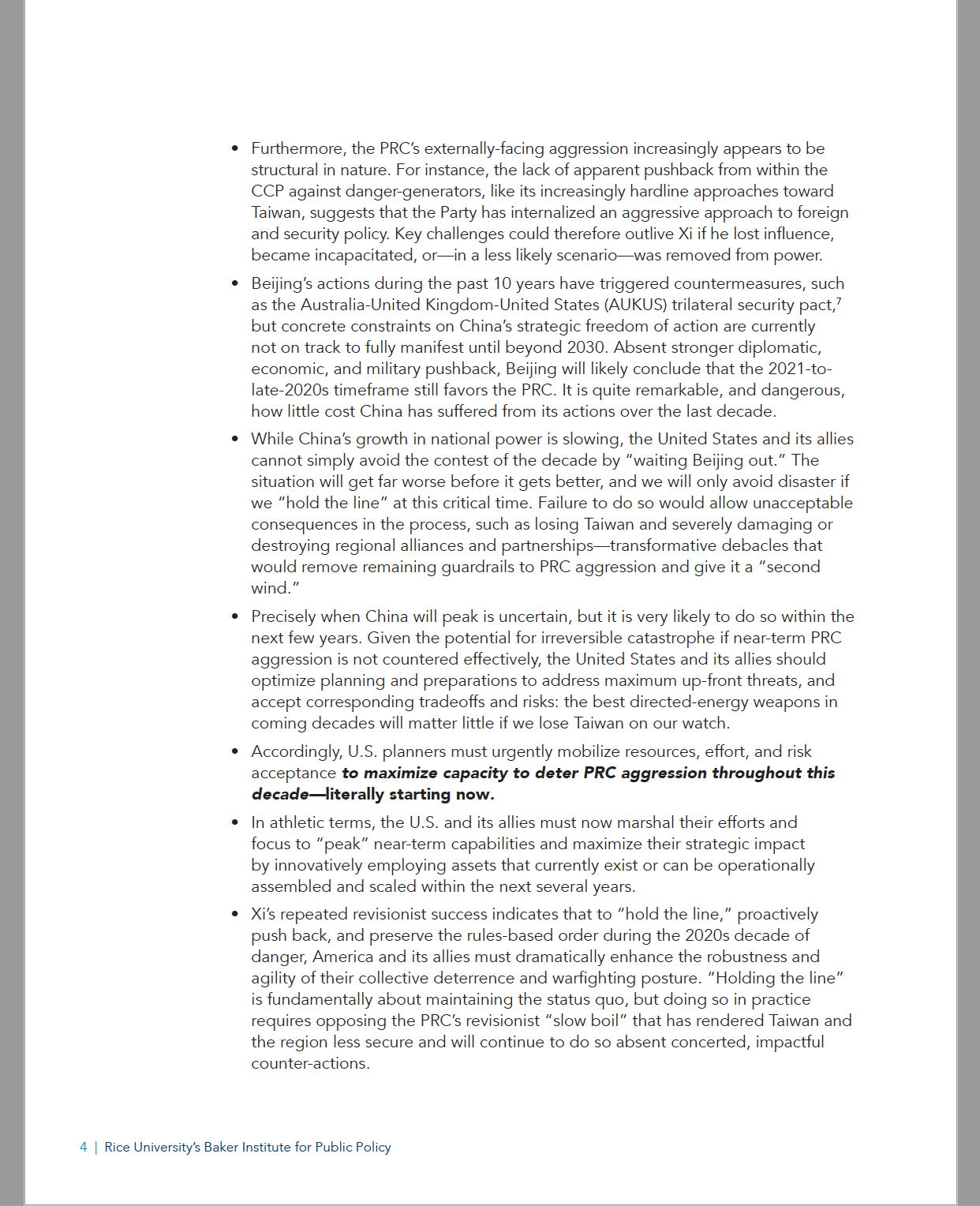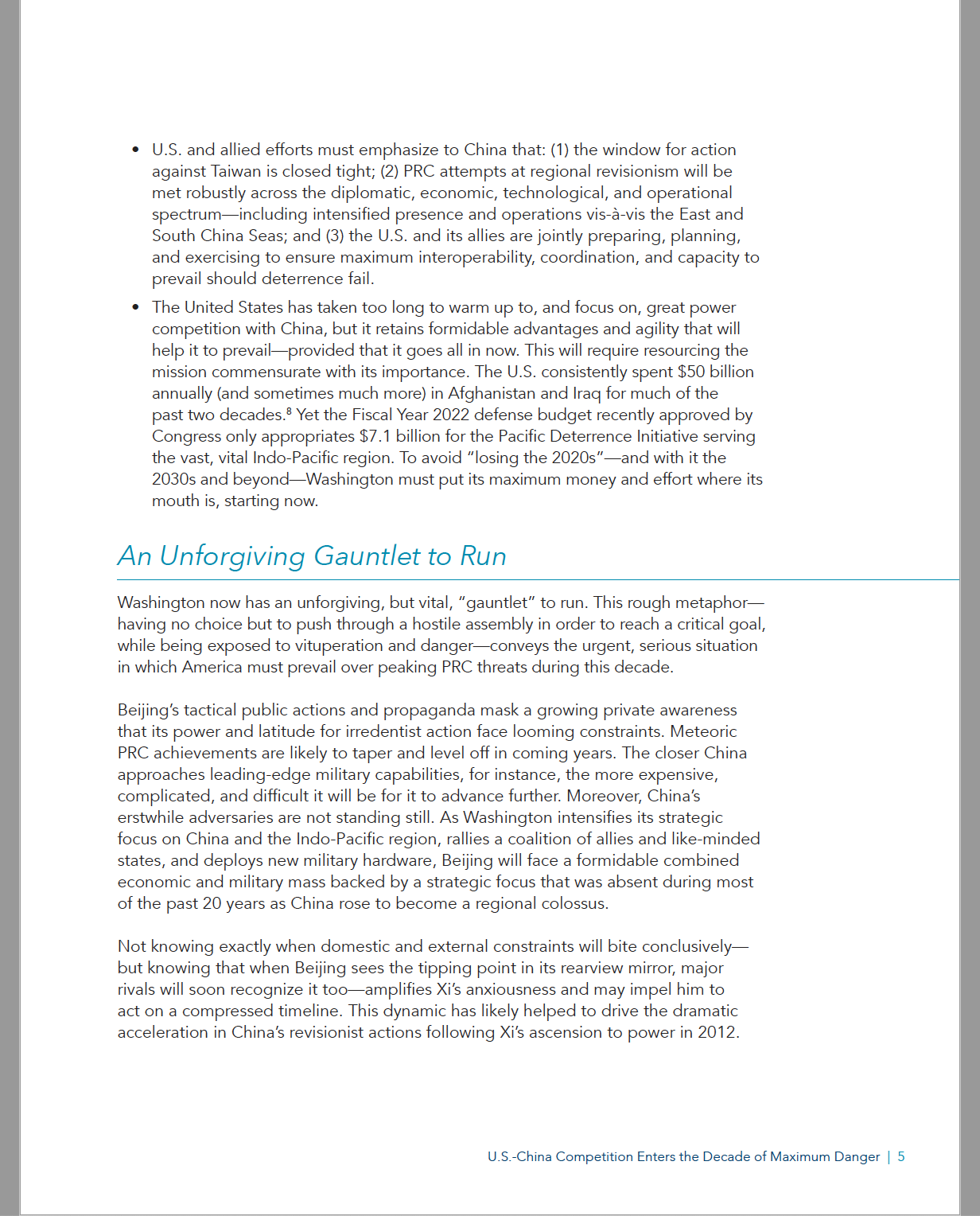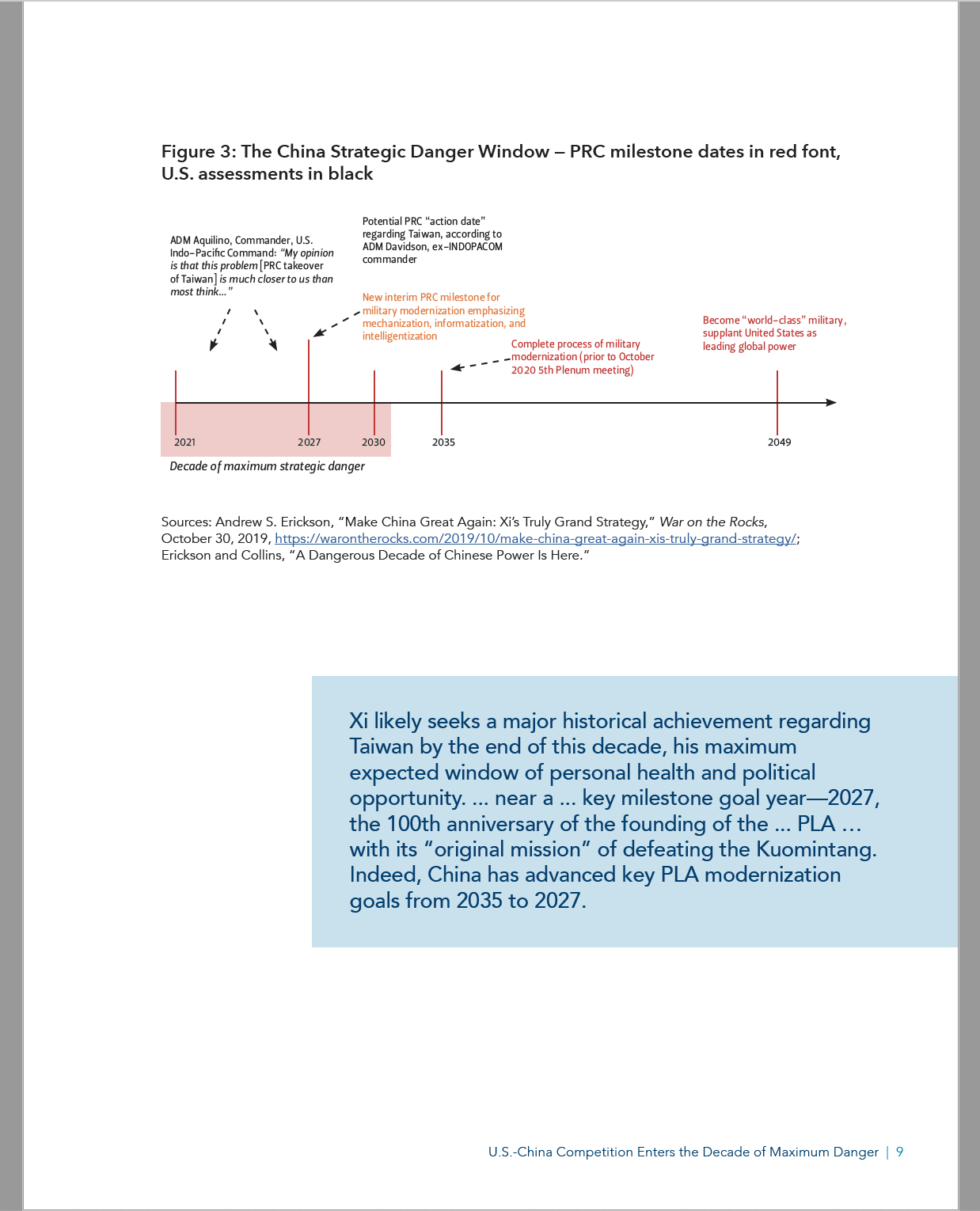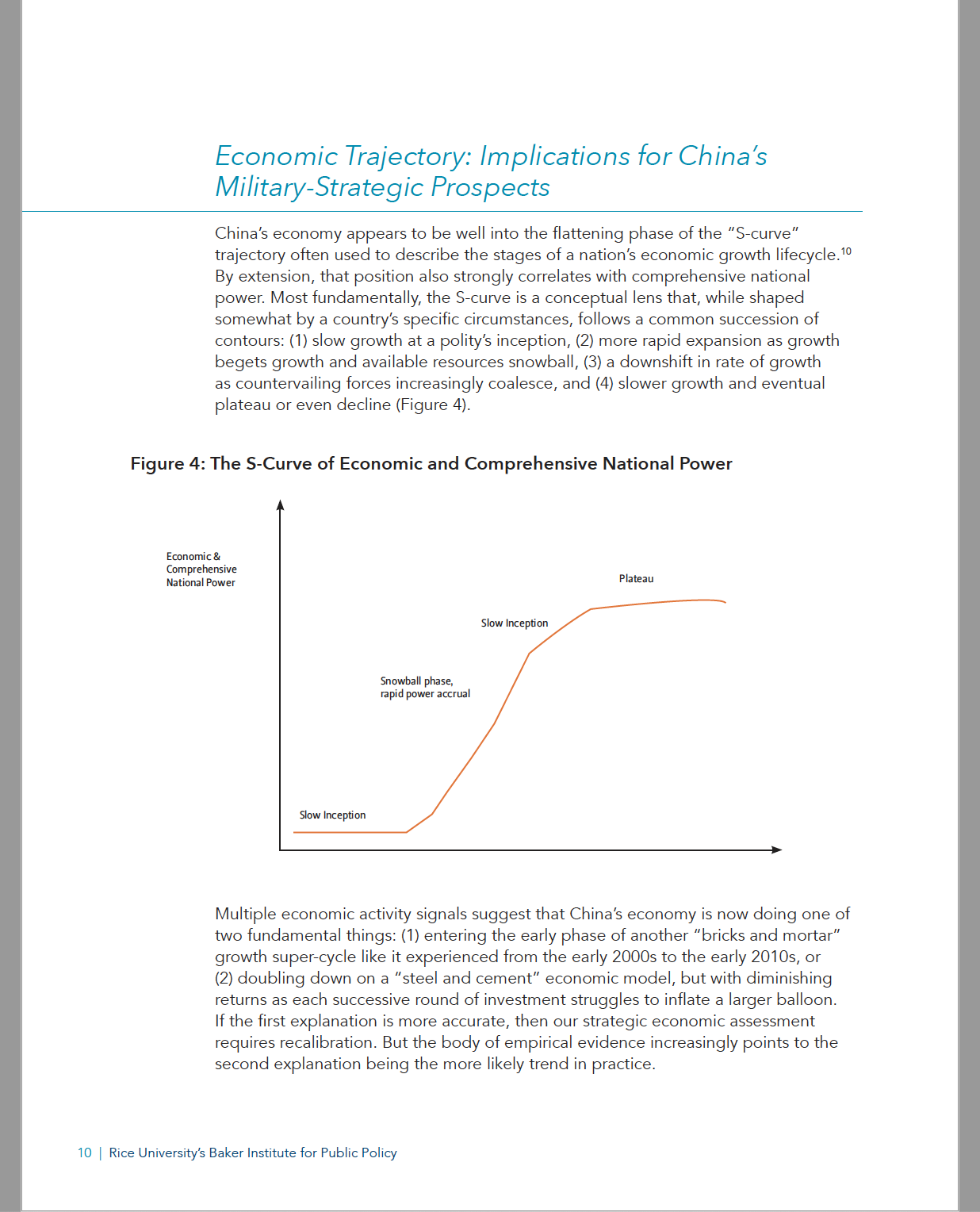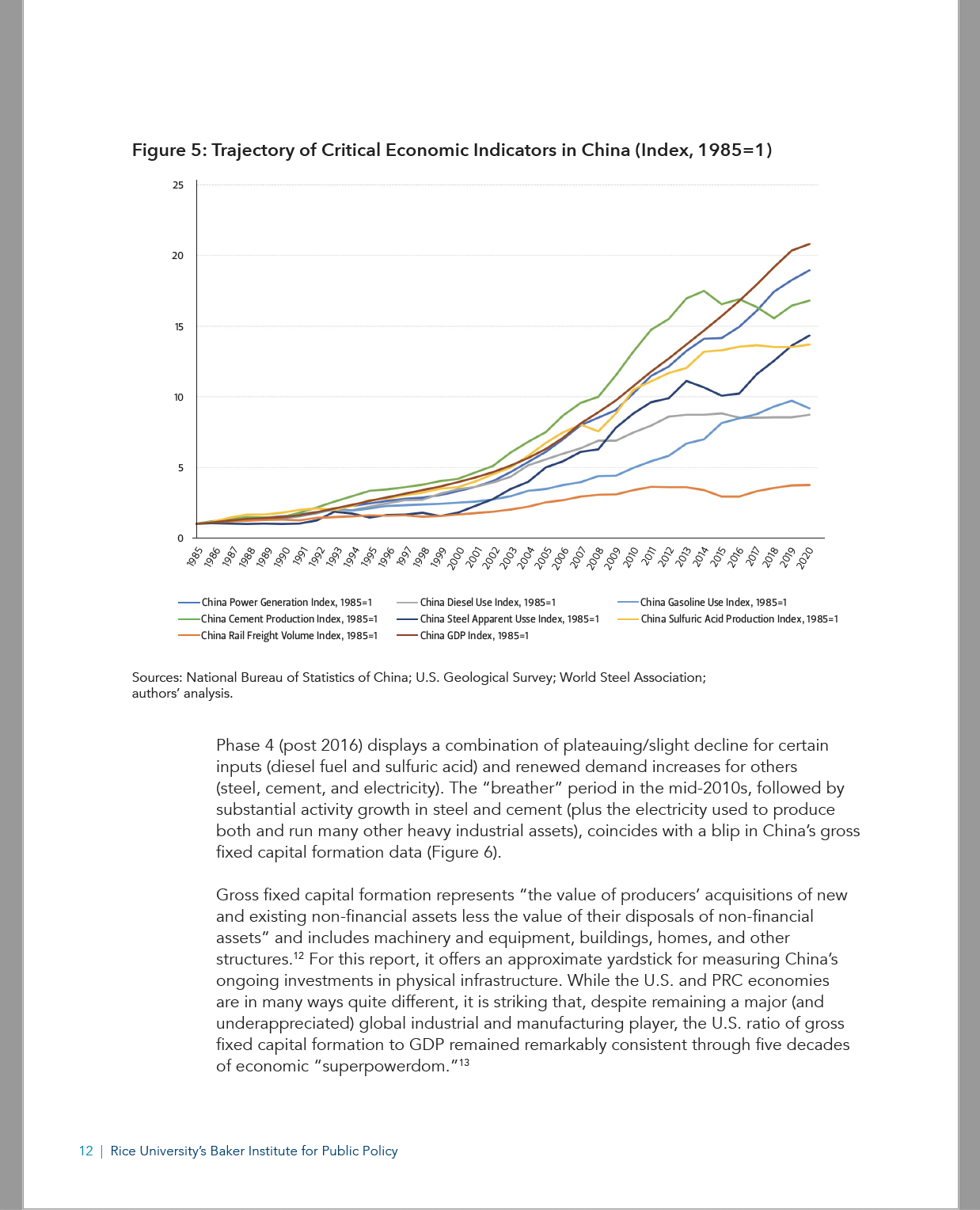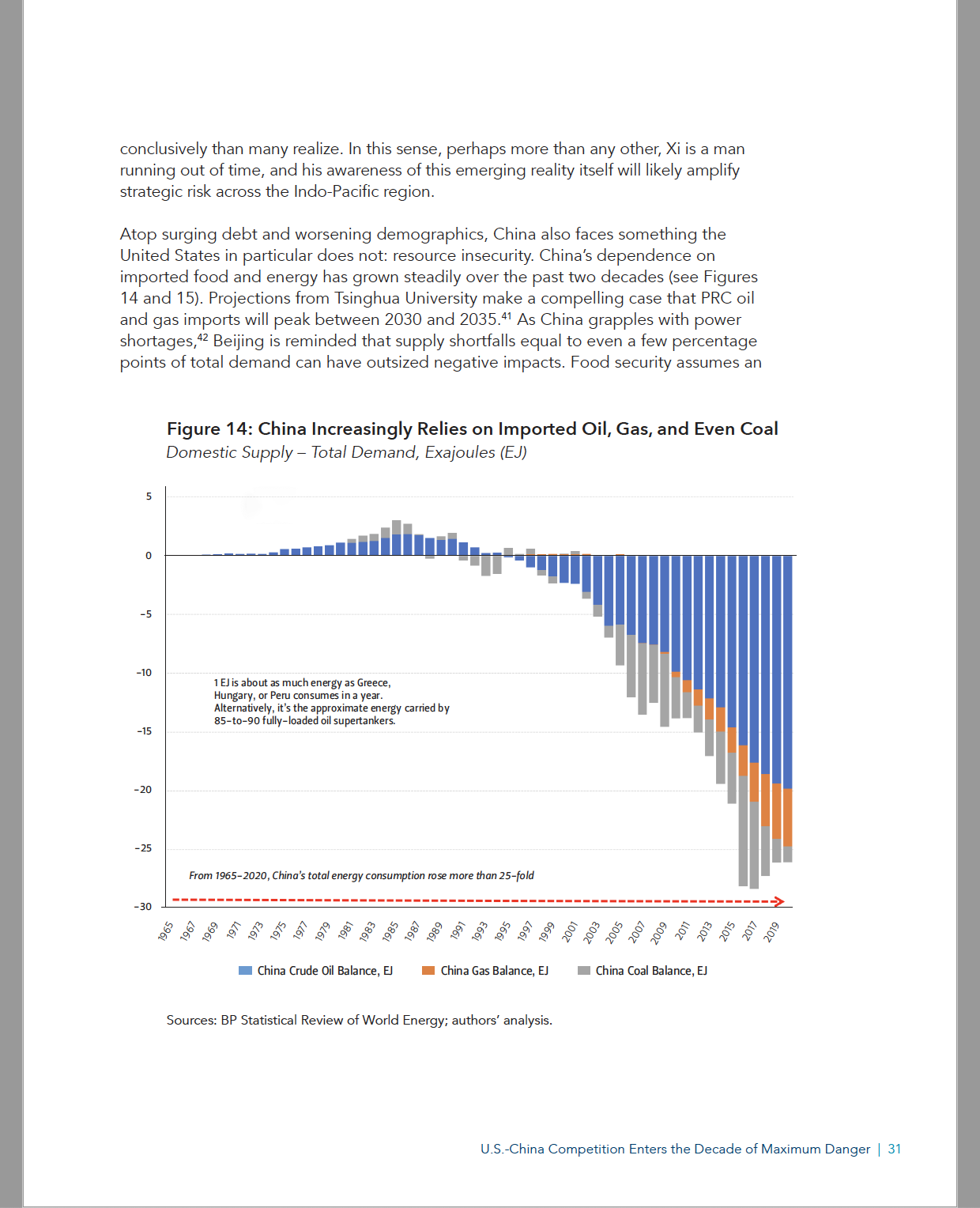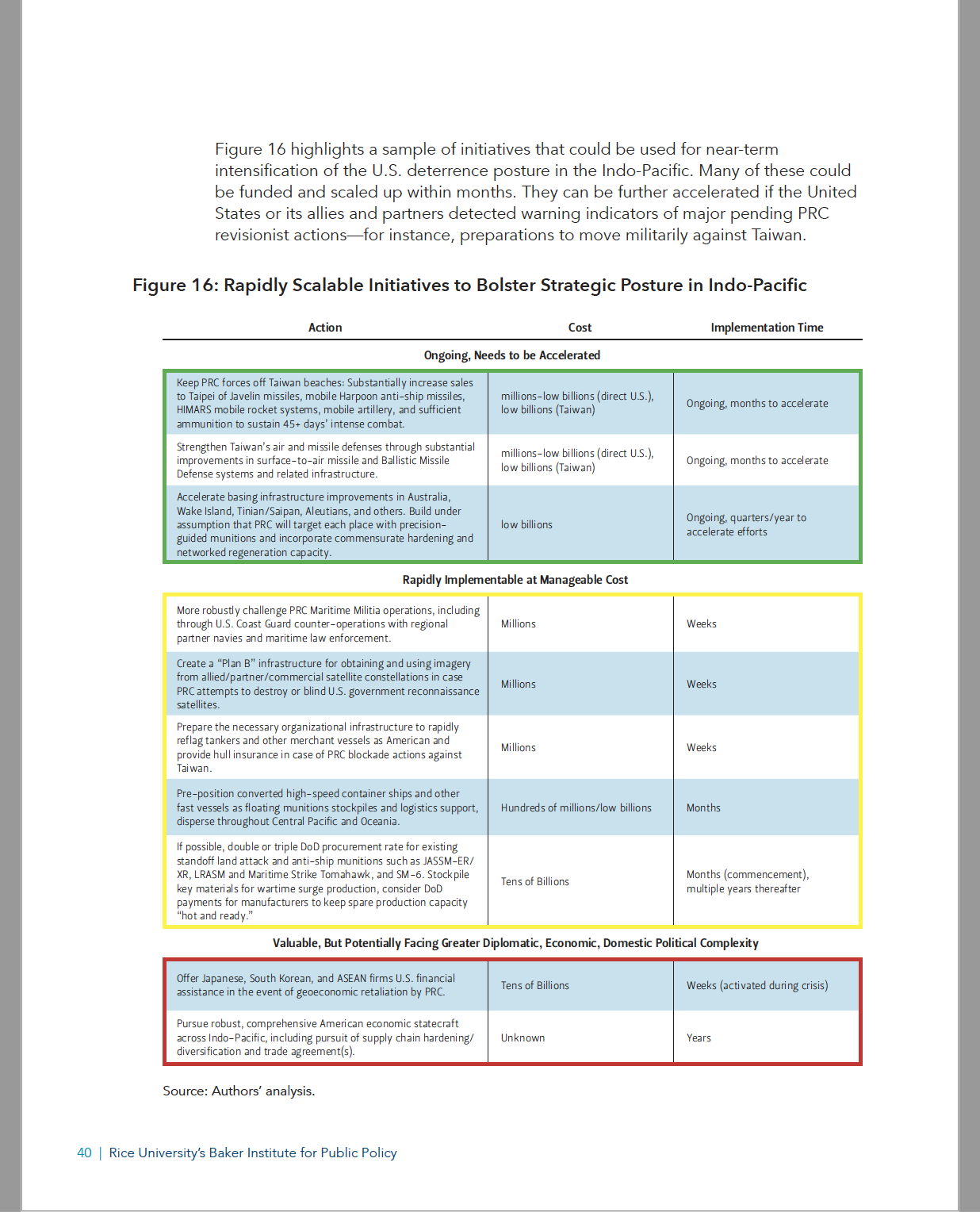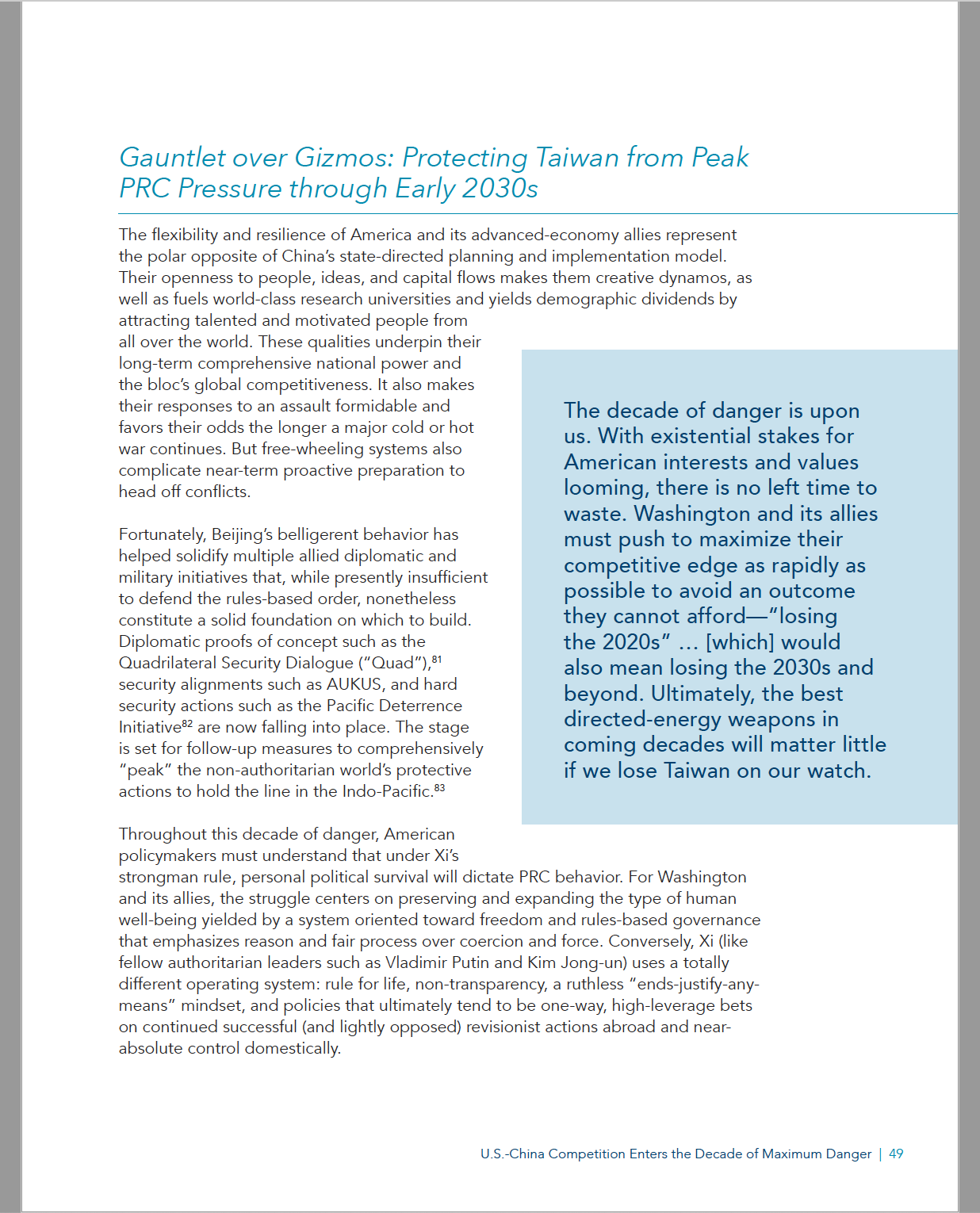U.S.-China Competition Enters the Decade of Maximum Danger: Policy Ideas to Avoid Losing the 2020s
Gabriel B. Collins and Andrew S. Erickson, U.S.-China Competition Enters the Decade of Maximum Danger: Policy Ideas to Avoid Losing the 2020s (Houston, TX: Baker Institute for Public Policy, Rice University, 20 December 2021).
As China’s relative power peaks during this decade, Xi Jinping is likely to make a catastrophic move against Taiwan if he calculates that his probability of success is sufficiently high. To protect American interests, regional security, and the rules-based international order, the United States and its allies must immediately mobilize resources to deter PRC aggression.
Click here to download a cached copy.
EXECUTIVE SUMMARY
- U.S. and allied policymakers now face a “decade of danger” through roughly 2030 emanating from the confluence of a peaking paramount leader (Chinese President Xi Jinping), a peaking Chinese Communist Party (CCP), and a peaking People’s Republic of China (PRC) as the country begins to experience the “S-curved slowdown”1 common to great powers.
- The PRC has achieved an extraordinary rise in power over the last two-plus decades and has succeeded in multiple regional coercion actions over the past decade; but its comprehensive national power will likely peak between 2030 and 2035—or, quite possibly, sooner.
- Within the next five years, PRC leaders are likely to privately conclude that China’s deteriorating demographic profile, structural economic problems, and technological estrangement from global innovation centers are eroding its leverage vis-à-vis Taiwan and other strategic objectives. As Xi internalizes these challenges, his foreign policy is likely to become even more risk-embracing.
- Xi’s risk appetite will likely be amplified by his nearly decade-long track record of successful revisionist actions against the rules-based order. Notable examples include the PRC perpetrating atrocities against humanity in Xinjiang,2 coercively enveloping Hong Kong,3 occupying Bhutanese lands,4 violently challenging its borders with India, occupying and militarizing disputed features and zones in the South China Sea,5 ramping up air and maritime incursions against Japan and Taiwan,6 and seeking to illegally restrict or endanger foreign military activities in international waters and airspace even as it operates permissively—sometimes covertly, sometimes aggressively—around the world and across all domains.
- For the Party, these “victories” have substantively exhausted the “lower-cost, high-payoff” options for aggrandizement, while emboldening Beijing as it eyes the biggest single revisionist prize: Taiwan.
- Xi, the CCP he leads, and the PRC they control, are presently pursuing extremely ambitious strategic goals for China’s “national rejuvenation.” Addressed in the nation’s five-year plans, these objectives are linked to key anniversaries, including two centenaries—the 100th anniversary of the CCP’s founding in 2021 and that of the PRC in 2049.
- Unless deterred successfully, Xi likely seeks a major historical achievement regarding Taiwan by the end of this decade, his maximum expected window of personal health and political opportunity. The 68-year-old leader, whose personal abilities, preparations, and available national power are all coming to a peak, will likely be tempted to make his mark on history through a major move against Taiwan near a third key milestone goal year—2027, the 100th anniversary of the founding of the People’s Liberation Army (PLA), with its “original mission” of defeating the Kuomintang. Indeed, China has advanced key PLA modernization goals from 2035 to 2027.
- Furthermore, the PRC’s externally-facing aggression increasingly appears to be structural in nature. For instance, the lack of apparent pushback from within the CCP against danger-generators, like its increasingly hardline approaches toward Taiwan, suggests that the Party has internalized an aggressive approach to foreign and security policy. Key challenges could therefore outlive Xi if he lost influence, became incapacitated, or—in a less likely scenario—was removed from power.
- Beijing’s actions during the past 10 years have triggered countermeasures, such as the Australia-United Kingdom-United States (AUKUS) trilateral security pact,7 but concrete constraints on China’s strategic freedom of action are currently not on track to fully manifest until beyond 2030. Absent stronger diplomatic, economic, and military pushback, Beijing will likely conclude that the 2021-to-late-2020s timeframe still favors the PRC. It is quite remarkable, and dangerous, how little cost China has suffered from its actions over the last decade.
- While China’s growth in national power is slowing, the United States and its allies cannot simply avoid the contest of the decade by “waiting Beijing out.” The situation will get far worse before it gets better, and we will only avoid disaster if we “hold the line” at this critical time. Failure to do so would allow unacceptable consequences in the process, such as losing Taiwan and severely damaging or destroying regional alliances and partnerships—transformative debacles that would remove remaining guardrails to PRC aggression and give it a “second wind.”
- Precisely when China will peak is uncertain, but it is very likely to do so within the next few years. Given the potential for irreversible catastrophe if near-term PRC aggression is not countered effectively, the United States and its allies should optimize planning and preparations to address maximum up-front threats, and accept corresponding tradeoffs and risks: the best directed-energy weapons in coming decades will matter little if we lose Taiwan on our watch.
- Accordingly, U.S. planners must urgently mobilize resources, effort, and risk acceptance to maximize capacity to deter PRC aggression throughout this decade—literally starting now.
- In athletic terms, the U.S. and its allies must now marshal their efforts and focus to “peak” near-term capabilities and maximize their strategic impact by innovatively employing assets that currently exist or can be operationally assembled and scaled within the next several years.
- Xi’s repeated revisionist success indicates that to “hold the line,” proactively push back, and preserve the rules-based order during the 2020s decade of danger, America and its allies must dramatically enhance the robustness and agility of their collective deterrence and warfighting posture. “Holding the line” is fundamentally about maintaining the status quo, but doing so in practice requires opposing the PRC’s revisionist “slow boil” that has rendered Taiwan and the region less secure and will continue to do so absent concerted, impactful counter-actions.
- U.S. and allied efforts must emphasize to China that: (1) the window for action against Taiwan is closed tight; (2) PRC attempts at regional revisionism will be met robustly across the diplomatic, economic, technological, and operational spectrum—including intensified presence and operations vis-à-vis the East and South China Seas; and (3) the U.S. and its allies are jointly preparing, planning, and exercising to ensure maximum interoperability, coordination, and capacity to prevail should deterrence fail.
- The United States has taken too long to warm up to, and focus on, great power competition with China, but it retains formidable advantages and agility that will help it to prevail—provided that it goes all in now. This will require resourcing the mission commensurate with its importance. The U.S. consistently spent $50 billion annually (and sometimes much more) in Afghanistan and Iraq for much of the past two decades.8 Yet the Fiscal Year 2022 defense budget recently approved by Congress only appropriates $7.1 billion for the Pacific Deterrence Initiative serving the vast, vital Indo-Pacific region. To avoid “losing the 2020s”—and with it the 2030s and beyond—Washington must put its maximum money and effort where its mouth is, starting now.
An Unforgiving Gauntlet to Run
Washington now has an unforgiving, but vital, “gauntlet” to run. This rough metaphor—having no choice but to push through a hostile assembly in order to reach a critical goal, while being exposed to vituperation and danger—conveys the urgent, serious situation in which America must prevail over peaking PRC threats during this decade.
Beijing’s tactical public actions and propaganda mask a growing private awareness that its power and latitude for irredentist action face looming constraints. Meteoric PRC achievements are likely to taper and level off in coming years. The closer China approaches leading-edge military capabilities, for instance, the more expensive, complicated, and difficult it will be for it to advance further. Moreover, China’s erstwhile adversaries are not standing still. As Washington intensifies its strategic focus on China and the Indo-Pacific region, rallies a coalition of allies and like-minded states, and deploys new military hardware, Beijing will face a formidable combined economic and military mass backed by a strategic focus that was absent during most of the past 20 years as China rose to become a regional colossus.
Not knowing exactly when domestic and external constraints will bite conclusively—but knowing that when Beijing sees the tipping point in its rearview mirror, major rivals will soon recognize it too—amplifies Xi’s anxiousness and may impel him to act on a compressed timeline. This dynamic has likely helped to drive the dramatic acceleration in China’s revisionist actions following Xi’s ascension to power in 2012. … … …
Gauntlet over Gizmos: Protecting Taiwan from Peak PRC Pressure through Early 2030s
The flexibility and resilience of America and its advanced-economy allies represent the polar opposite of China’s state-directed planning and implementation model. Their openness to people, ideas, and capital flows makes them creative dynamos, as well as fuels world-class research universities and yields demographic dividends by attracting talented and motivated people from all over the world. These qualities underpin their long-term comprehensive national power and the bloc’s global competitiveness. It also makes their responses to an assault formidable and favors their odds the longer a major cold or hot war continues. But free-wheeling systems also complicate near-term proactive preparation to head off conflicts.
Fortunately, Beijing’s belligerent behavior has helped solidify multiple allied diplomatic and military initiatives that, while presently insufficient to defend the rules-based order, nonetheless constitute a solid foundation on which to build. Diplomatic proofs of concept such as the Quadrilateral Security Dialogue (“Quad”),81 security alignments such as AUKUS, and hard security actions such as the Pacific Deterrence Initiative82 are now falling into place. The stage is set for follow-up measures to comprehensively “peak” the non-authoritarian world’s protective actions to hold the line in the Indo-Pacific.83
Throughout this decade of danger, American policymakers must understand that under Xi’s strongman rule, personal political survival will dictate PRC behavior. For Washington and its allies, the struggle centers on preserving and expanding the type of human well-being yielded by a system oriented toward freedom and rules-based governance that emphasizes reason and fair process over coercion and force. Conversely, Xi (like fellow authoritarian leaders such as Vladimir Putin and Kim Jong-un) uses a totally different operating system: rule for life, non-transparency, a ruthless “ends-justify-any-means” mindset, and policies that ultimately tend to be one-way, high-leverage bets on continued successful (and lightly opposed) revisionist actions abroad and near-absolute control domestically.
Xi’s personalist leadership and nearly comprehensive suppression of dissenting voices in the Party’s senior ranks simultaneously raises the chances of making policy mistakes while reducing the flexibility to deal with them early. In such an embrittled system, the proverbial “leverage” that would have left Xi with outsized returns on a successful bet instead amplifies the downside, all for which he personally and exclusively signed. The “best-case” scenario entails continued stagnation and rot within the Party along the lines of what Minxin Pei has articulated.84 The “intermediate case” is an accelerated version of that, with Xi suffering a loss of status and authority on the heels of a policy disaster, internal challengers rising within the PRC, and internecine strife leading to accelerated weakening of the Party. The “bad case” scenario—which, in practice, would likely be interrelated with the intermediate one—is that Xi would double down on a mistaken course of action to prioritize political self-preservation. If such mistakes led to—or were made in the course of—a kinetic conflict, personal survival measures could rapidly transmute into regional or even global (i.e., nuclear, space, cyber) threats.
If Xi triggered a “margin call” on his personal political account through a failed high-stakes gamble, it would likely be paid in blood. Washington must thus prepare the American electorate and its institutional and physical infrastructure, as well as that of allies and partners abroad, for the likelihood that tensions will periodically ratchet up to uncomfortable levels—and that, despite the promise of determined deterrence, actual conflict cannot be ruled out. Si vis pacem, para bellum (“If you want peace, prepare for war”) must unfortunately serve as a central organizing principle for a range of U.S. and allied decisions during the next decade with respect to China under Xi.85
Given these unforgiving dynamics, the implications for U.S. leaders and planners are stark:
- Do whatever remains possible to reach “peak” preparedness for deterrent competition against China by the mid-to-late 2020s and accept the tradeoffs.86
- Nothing the U.S and its allies might theoretically achieve after 2035 is worth pursuing at the expense of realistic capabilities relevant to defending Taiwan that currently exist or can be operationally assembled and scaled within the next several years.
- Much will be decided by the end of this decade. If America falters at this critical time—whether through creeping corrosion of the rules-based order at Beijing’s hands or the shocking impact of failing to defend Taiwan against military attack—many aspects of the world and future will be determined at the expense of U.S. interests and values.
The decade of danger is upon us. With existential stakes for American interests and values looming, there is no time left to waste. Washington and its allies must push to maximize their competitive edge as rapidly as possible to avoid an outcome they cannot afford—“losing the 2020s.” At what point the PRC reaches its peak may ultimately defy precise prediction, but the strong possibility of it occurring over the next few years should front-load America’s bottom-line planning and preparations, given the potential for irreversible linchpin effects. Near-term preparation to run this decade’s unforgiving gauntlet justifies any corresponding long-term tradeoffs and risks: “losing the 2020s” would also mean losing the 2030s and beyond. Ultimately, the best achievements in coming decades will matter little if we lose Taiwan on our watch. More broadly, allowing PRC revisionism to run as rampant in the 2020s as it did in the 2010s would risk negatively reshaping the world order for decades to come and could actually set the stage for even worse conflicts by destabilizing the planet’s most populous region. Alternatively, proactive deterrence actions now can sow the seeds for a more peaceful and prosperous future that would benefit all Indo-Pacific countries, China included. The mission is vital, the stakes are high, and the clock is ticking.

